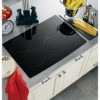GE PP950BMBB Owners Manual - Page 13
Control Lock Pad, Glass Cooktop
 |
View all GE PP950BMBB manuals
Add to My Manuals
Save this manual to your list of manuals |
Page 13 highlights
Safety Instructions Operating Instructions Care and Cleaning Troubleshooting Tips Consumer Support Cleaning the glass cooktop. ge.com CONTROL LOCK Control Lock Pad As a convenience, you can lock the entire cooktop at any time when it is not in use or before cleaning. Locking the cooktop will prevent surface elements from being turned on accidently. Begin by locking the cooktop; see the Locking the Cooktop section. Use the same cleaning methods as those described for the glass-ceramic top. Clean your cooktop after each spill. Use ceramic cooktop cleaner. Normal Daily Use Cleaning ONLY use ceramic cooktop cleaner on the glass cooktop. Other creams may not be as effective. To maintain and protect the surface of your glass cooktop, follow these steps: Before using the cooktop for the first time, clean it with ceramic cooktop cleaner. This helps protect the top and makes cleanup easier. Daily use of ceramic cooktop cleaner will help keep the cooktop looking new. Shake the cleaning cream well. Apply a few drops of ceramic cooktop cleaner directly to the cooktop. Use a paper towel or cleaning pad for ceramic cooktops to clean the entire cooktop surface. Use a dry cloth or paper towel to remove all cleaning residue. No need to rinse. NOTE: It is very important that you DO NOT heat the cooktop until it has been cleaned thoroughly. Use a cleaning pad for ceramic cooktops. Burned-On Residue WARNING: DAMAGE to your glass surface may occur if you use scrub pads other than the pad included with your cooktop. Allow the cooktop to cool. Spread a few drops of ceramic cooktop cleaner on the entire burned residue area. Using the included cleaning pad for ceramic cooktops, rub the residue area, applying pressure as needed. The ceramic cooktop scraper and all recommended supplies are available through our Parts Center. See instructions under "To Order Parts" section on next page. NOTE: Do not use a dull or nicked blade. Heavy, Burned-On Residue Allow the cooktop to cool. Use a single-edge razor blade scraper at approximately a 45° angle against the glass surface and scrape the soil. It will be necessary to apply pressure to the razor scraper in order to remove the residue. After scraping with the razor scraper, spread a few drops of ceramic cooktop cleaner on the entire burned residue area. Use If any residue remains, repeat the steps listed above as needed. For additional protection, after all residue has been removed, polish the entire surface with ceramic cooktop cleaner and a paper towel. the cleaning pad to remove any remaining residue. For additional protection, after all residue has been removed, polish the entire surface with ceramic cooktop cleaner and a paper towel. 13















